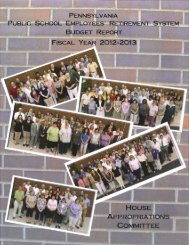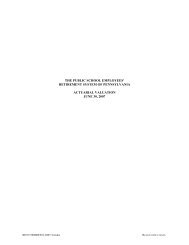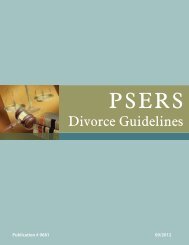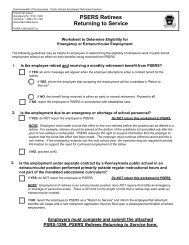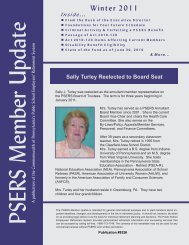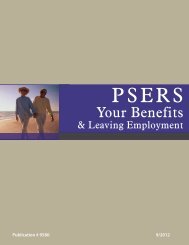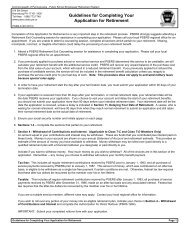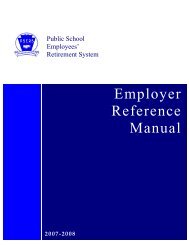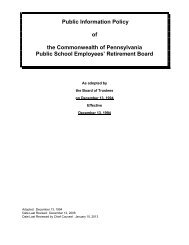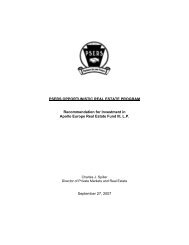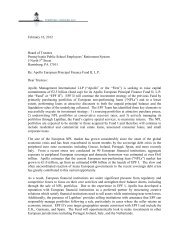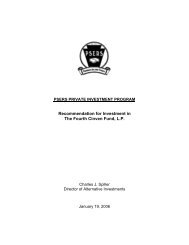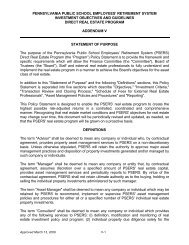a complete copy of the 2012 CAFR Report! - PSERs
a complete copy of the 2012 CAFR Report! - PSERs
a complete copy of the 2012 CAFR Report! - PSERs
You also want an ePaper? Increase the reach of your titles
YUMPU automatically turns print PDFs into web optimized ePapers that Google loves.
FINANCIAL SECTION<br />
Management’s Discussion and Analysis (continued)<br />
• Cannot withdraw contributions and interest in a<br />
lump sum when retiring.<br />
• Pension benefit cannot exceed <strong>the</strong> member’s final<br />
average salary.<br />
• New employees starting later than July 1, 2011 will<br />
contribute based on <strong>the</strong> “shared risk” rate in effect<br />
at date <strong>of</strong> hire.<br />
Benefit and contribution rates for <strong>the</strong> new membership<br />
classes are as follows:<br />
Class T-E<br />
• Final average salary multiplier is 2% as opposed to<br />
2.5% multiplier for most current members.<br />
• Employee contribution base rate is 7.5% (base rate)<br />
with a “shared risk” provision that could cause <strong>the</strong><br />
total contribution levels to fluctuate between 7.5%<br />
and 9.5%.<br />
Class T-F<br />
• Final average salary multiplier is 2.5%.<br />
• Employee contribution base rate is 10.3% (base<br />
rate) with a “shared risk” provision that could<br />
cause <strong>the</strong> total contribution levels to fluctuate<br />
between 10.3% and 12.3%.<br />
With a “shared risk” program, Class T-E and T-F<br />
members benefit when investments <strong>of</strong> <strong>the</strong> fund are<br />
doing well and share some <strong>of</strong> <strong>the</strong> risk when investments<br />
underperform. The member contribution rate will stay<br />
within <strong>the</strong> specified range allotted for Class T-E or<br />
T-F; but could increase or decrease by .5% every three<br />
years starting July 1, 2015, dependent on investment<br />
performance <strong>of</strong> PSERS. The member contribution rate<br />
could never go below <strong>the</strong> base rate <strong>of</strong> 7.5% for T-E and<br />
10.3% for T-F members, or above 9.5% for T-E and<br />
12.3% for T-F members.<br />
Funding/Actuarial Changes Summary<br />
Funding Changes - Employer Contributions<br />
The legislation also suppresses <strong>the</strong> employer<br />
contribution rate by using rate caps in future years to<br />
keep <strong>the</strong> rate from rising too high, too fast for budgetary<br />
purposes.<br />
The rate caps limit <strong>the</strong> amount <strong>the</strong> pension component<br />
<strong>of</strong> <strong>the</strong> employer contribution rate can increase over <strong>the</strong><br />
prior year’s rate as follows:<br />
• FY <strong>2012</strong> - not more than 3.0% plus <strong>the</strong> premium<br />
assistance contribution rate<br />
• FY 2013 - not more than 3.5% plus <strong>the</strong> premium<br />
assistance contribution rate<br />
• FY 2014 and <strong>the</strong>reafter - not more than 4.5% plus<br />
<strong>the</strong> premium assistance contribution rate<br />
The rate cap remains at 4.5% until <strong>the</strong> rate cap no<br />
longer applies, i.e. <strong>the</strong> rise in <strong>the</strong> employer contribution<br />
rate is less than <strong>the</strong> rate cap in effect at that time. Once<br />
<strong>the</strong> rate caps no longer apply, <strong>the</strong> employer normal cost<br />
becomes <strong>the</strong> contribution rate floor.<br />
Actuarial Changes<br />
• Currently liabilities are funded over various<br />
periods <strong>of</strong> time using level dollar amortization.<br />
Act 120 re-amortizes all unfunded liabilities over<br />
a 24 year period and uses level percentage <strong>of</strong> pay<br />
amortization.<br />
• Level percentage <strong>of</strong> pay amortization is calculated<br />
using <strong>the</strong> same percentage <strong>of</strong> compensation each<br />
year during <strong>the</strong> amortization period. Under <strong>the</strong><br />
level dollar amortization, <strong>the</strong> annual dollar amount<br />
<strong>of</strong> <strong>the</strong> payment remains <strong>the</strong> same each year.<br />
• Act 120 changes <strong>the</strong> recognition <strong>of</strong> investment<br />
gains and losses from a five year smoothing period<br />
to a ten year smoothing period.<br />
• Any future legislation enacted that adds liabilities<br />
to <strong>the</strong> system (i.e. cost-<strong>of</strong>-living adjustments, “30<br />
and Out”) will be amortized over ten years, using<br />
a level percentage <strong>of</strong> pay method. The cost <strong>of</strong> any<br />
additional accrued liability must be reflected above<br />
<strong>the</strong> employer contribution rate caps.<br />
• The use <strong>of</strong> Pension Obligation Bonds to fund <strong>the</strong><br />
System is prohibited.<br />
PAGE 32



